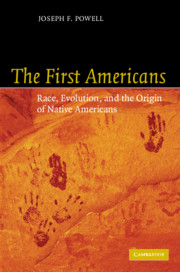Book contents
- Frontmatter
- Contents
- Acknowledgments
- Prologue: The Kennewick controversy
- PART I Race and variation
- PART II The Pleistocene peopling of the Americas
- 5 The Pleistocene and ice-age environments
- 6 Ancient cultures and migration to the Americas
- 7 Kennewick Man and his contemporaries
- 8 Human variation in the Pleistocene
- PART III The First Americans, race and evolution
- References
- Index
7 - Kennewick Man and his contemporaries
Published online by Cambridge University Press: 21 August 2009
- Frontmatter
- Contents
- Acknowledgments
- Prologue: The Kennewick controversy
- PART I Race and variation
- PART II The Pleistocene peopling of the Americas
- 5 The Pleistocene and ice-age environments
- 6 Ancient cultures and migration to the Americas
- 7 Kennewick Man and his contemporaries
- 8 Human variation in the Pleistocene
- PART III The First Americans, race and evolution
- References
- Index
Summary
PALEOINDIAN OR EARLY ARCHAIC?
The bulk of ancient skeletons in the Americas date to the warmer post-glacial period known geologically as the early Holocene (10,000– 8500 yr BP), or culturally as the Early Archaic period. People from this period have been thought of as direct descendents of the Clovis (11,500–10,900 yr BP), and later Folsom (10,000–8500 yr BP) colonizers in the Americas (Fagan, 1987; Meltzer, 1993b, 2001). While most skeletal biologists who deal with ancient American skeletons recognize that these remains are not truly Late Pleistocene or “Paleoindian” in age, several of us continue to use the Paleoindian moniker to distinguish early skeletons dating from about 10,900 to 8500 yr BP. The rest of this chapter provides an overview of Paleoindian and Early Archaic skeletons found in the Americas.
SUMMARY OF ANCIENT SKELETONS IN NORTH AMERICA
Northeastern USA
Trenton site, NJ (1877–1892)
As discussed in Chapters 1 and 2, the Pleistocene gravels of Trenton, New Jersey, produced what appeared to be Paleolithic tools in association with fragmentary human skeletal remains (Abbott, 1876a; Holmes, 1892). However, the Trenton remains have recently been proven to be a modern skeleton incorporated into Pleistocene deposits. Other than this set of remains, there are no other suspected ancient human remains in the northeastern USA, which argues against the Solutrean model of colonization.
- Type
- Chapter
- Information
- The First AmericansRace, Evolution and the Origin of Native Americans, pp. 128 - 168Publisher: Cambridge University PressPrint publication year: 2005



